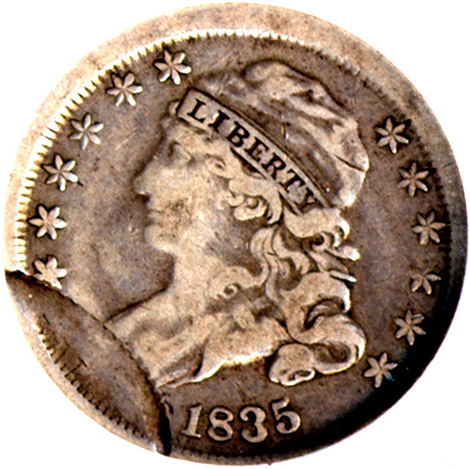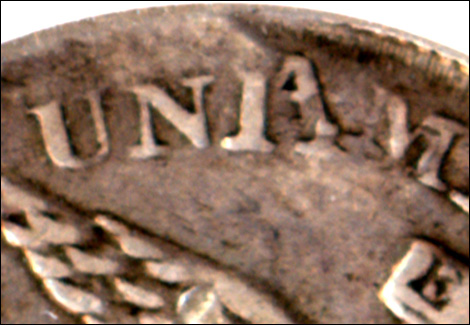 This is a very unusual 1835 bust dime. The obverse shows an indentation (brockage) from an already-struck bust dime at the 7:30 clock position.
This is a very unusual 1835 bust dime. The obverse shows an indentation (brockage) from an already-struck bust dime at the 7:30 clock position.

 On the reverse, directly behind this indentation, the letters AMERI from the reverse die are situated exactly where the letters TED ST of UNITED STATES ought to be, creating the composite word UNIAMERIATES.
On the reverse, directly behind this indentation, the letters AMERI from the reverse die are situated exactly where the letters TED ST of UNITED STATES ought to be, creating the composite word UNIAMERIATES.

 And finally the edge (”third side”) of the coin displays a partial collar in that there is a blank area of the edge toward the obverse side, with full normal edge reeding around the edge toward the reverse side. So how can we explain these unusual features?
And finally the edge (”third side”) of the coin displays a partial collar in that there is a blank area of the edge toward the obverse side, with full normal edge reeding around the edge toward the reverse side. So how can we explain these unusual features?
 First of all, it is clear that the coin has been struck twice. The first strike was well centered and created most of the detail of the coin. The second strike affected only the the indented region of the obverse and the unusual AMERI area of the reverse. The second strike occurred after this coin had rotated approximately 135 degrees but continued to sit on the reverse die. The second strike imparted the letters AMERI into the reverse of the coin where TED ST of UNITED STATES had been before. Evidence of both strikes can be seen together underneath the base of the A in AMERI from the second strike, where the the base of the T in UNITED from the first strike is still present.
First of all, it is clear that the coin has been struck twice. The first strike was well centered and created most of the detail of the coin. The second strike affected only the the indented region of the obverse and the unusual AMERI area of the reverse. The second strike occurred after this coin had rotated approximately 135 degrees but continued to sit on the reverse die. The second strike imparted the letters AMERI into the reverse of the coin where TED ST of UNITED STATES had been before. Evidence of both strikes can be seen together underneath the base of the A in AMERI from the second strike, where the the base of the T in UNITED from the first strike is still present.

 During the second strike there were 2 coins in the coining chamber at once: this coin and a previously struck coin that overlapped the obverse of this coin at the indented area. We know that the overlapping coin was previously struck because it left an arc of reeding around the indented area as well as some signs of lettering from its design. When the force of the second strike hit the 2 overlapping coins, the obverse of this coin became indented and the reverse was thrust onto the AMERI area of the reverse die.
During the second strike there were 2 coins in the coining chamber at once: this coin and a previously struck coin that overlapped the obverse of this coin at the indented area. We know that the overlapping coin was previously struck because it left an arc of reeding around the indented area as well as some signs of lettering from its design. When the force of the second strike hit the 2 overlapping coins, the obverse of this coin became indented and the reverse was thrust onto the AMERI area of the reverse die.
 The edge may provide a clue as to the sequence of events that gave rise to this piece. We know that this dime was struck twice and yet the edge has only a partial collar. That means that the collar functioned partially during one strike and did not function at all during the other.
The edge may provide a clue as to the sequence of events that gave rise to this piece. We know that this dime was struck twice and yet the edge has only a partial collar. That means that the collar functioned partially during one strike and did not function at all during the other.
 Here’s a possible scenario to account for how this coin came into existence. During the first strike the collar came up only part way and the ejection mechanism malfunctioned as well. That accounts for the partial collar on this coin and for the coin staying inside the coining chamber. A similar malfunction had affected the coin struck just before this coin, so that it too stayed in the coining chamber where it overlapped this coin and was then struck against it. During the second strike the collar could not come up around this coin at all because it had already been expanded to full inside-the-collar size by the first strike. Hence no reeding was imparted to the coin during the second strike.
Here’s a possible scenario to account for how this coin came into existence. During the first strike the collar came up only part way and the ejection mechanism malfunctioned as well. That accounts for the partial collar on this coin and for the coin staying inside the coining chamber. A similar malfunction had affected the coin struck just before this coin, so that it too stayed in the coining chamber where it overlapped this coin and was then struck against it. During the second strike the collar could not come up around this coin at all because it had already been expanded to full inside-the-collar size by the first strike. Hence no reeding was imparted to the coin during the second strike.
 It is exciting to contemplate a bust silver coin that possesses, as this one does, 3 different error features, one on each side of the coin (partial brockage on the obverse, double striking on the reverse, partial collar on the edge). Even more remarkable, these error features were simply left “as is” on this coin, whereas most other early error bust silver coins were put back into the screw press, probably by hand, and struck again to try to hide their error features. This one escaped that fate. I would love to hear of others like it if they’re out there!
It is exciting to contemplate a bust silver coin that possesses, as this one does, 3 different error features, one on each side of the coin (partial brockage on the obverse, double striking on the reverse, partial collar on the edge). Even more remarkable, these error features were simply left “as is” on this coin, whereas most other early error bust silver coins were put back into the screw press, probably by hand, and struck again to try to hide their error features. This one escaped that fate. I would love to hear of others like it if they’re out there!

